
views
Planning the Fort

Decide on your dimensions. To make a simple fort you can create a 3 ft wide by 3 ft deep pit. For a more complex fort, measure from your feet to shoulders to use as the depth and your total arms span for the width of the fort. You can also make a rectangular shaped fort; remember, the dimensions are up to you. To avoid the walls collapsing you'll want to angle each wall slightly so that the opening of the fort is a half foot wider than the base. Digging down further than 6 feet can be dangerous and isn't recommended as it's more likely for your fort walls to collapse and cause you or others harm. In order to avoid the walls collapsing, never dig deeper than you dig across. The ratio should at least be equal.
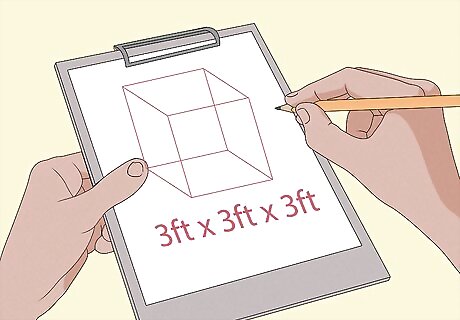
Draw out your plan. To help you 'see' the final product and to catch any structural issues, you should draw a sketch of what you want your fort to look like. Do this after you've picked the location so you have an idea of what you may need to work around – such as tree stumps or roots. An example fort plan would be a 3x3x3 foot square box dug into the ground. (You can angle the walls after digging the original design.) Write down the dimensions so you'll stick with the right measurements once you begin digging. Check out how much arm room you'll have by using suitable markers, pegs or flags, and arranging them on the floor, in sync with your fort dimensions. Sit in the mock fort to see if you'll be comfortable and it feels like the right width.

Do your research to find a safe place to dig. Make sure that the spot you choose is legally your property, or that you have permission to build your fort there. Call your local government to check for utility lines where you plan to dig. The space for your fort needs to be away from gas, electric, and sewer lines. Call 811 or any other relevant advice line where you live a couple of days before you dig and get help with locating utility lines in your area. Check with your parents, or other authority figures, before digging to get their permission. If there is a septic tank, the homeowner should know where it is so you can avoid it. If they don't, you may need to contact local septic tank pumping companies to ask if they've worked on it, look for records of the location in any materials you have about the property and house. As a last resort to find the septic tank, you can scan the yard for any differences in the grass in the shape of a large rectangle. The grass may not grow in the area on top of the sewage tank, or it may be growing much greener than the grass around it depending on the sewage emissions.
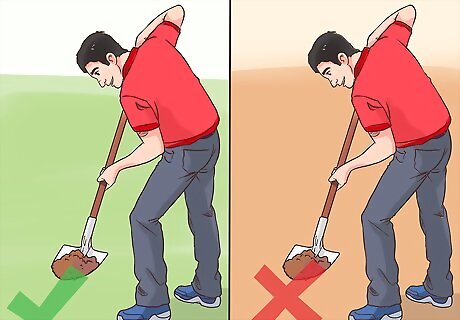
Pick the location and scan for debris. Avoid areas with lots of tree roots and rocks, which will make it difficult to dig. You may have to test out areas by digging around here and there before you find the best location, but always be sure to avoid muddy areas where water may pool into your fort after it rains. Ideally the space for your fort will have good drainage, be clear of anything sharp, and the ground will be more earth than rock. The best location will be in a grassy field. Avoid building an underground fort in sand. Do not dig a fort if you are in a flood zone.
Digging Your Fort

Bring friends to help you. Ask people to help dig, and always tell someone back home where you are. Even after building the fort it's safest to let someone know when you are going to be in it. If you have a cellphone, be sure to bring it in case of an emergency.
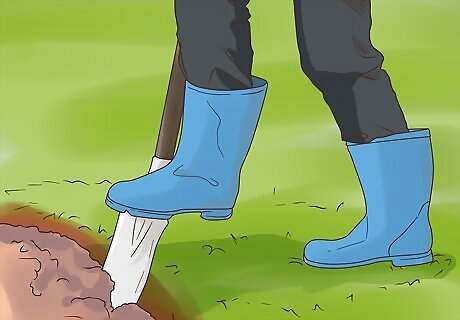
Dig your fort. Start by grabbing your shovel and skimming off the top of the soil in the dimensions you've decided on. Check your measurements and if they're correct go ahead and begin digging out your fort. Do your best to evenly dig down and reevaluate your dimensions often so you don't dig too far off of the plan. This will be hard work and may take a couple days, depending on the dimensions and how much time you have to dig. If you want to protect the work you've done, cover it with a tarp overnight. Hold down the corners of the tarp with small boulders or mounds of dirt. You may want to use the dirt you've dug out to mark where your fort is to avoid anyone falling in the pit. Build it up as walls around your fort but leave one side clear to make sure you can still enter and exit your fort safely. Otherwise, you may want to have a wheelbarrow to take the dirt to another area.
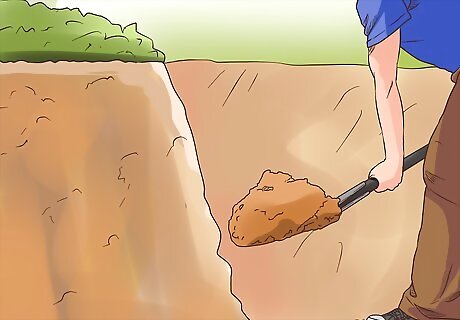
Slope your walls. To avoid collapse you will want to shape the walls of your fort so they are slightly wider and more open than the floor. You can skim off earth around the top of the fort while standing above the fort. Work your way down so that the top of the fort is 6 inches wider than the base and scrape the walls down with a small shovel so each one angles slightly out from there.
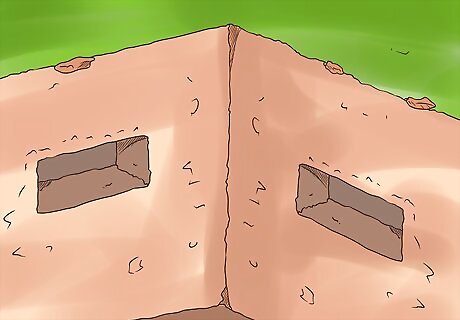
Dig out small cubbyholes. Create small nooks or shelves in your walls, with your hands or a small shovel, so you can keep items in the fort and have a place for your flashlight or lantern. Though a battery-powered light works best, keeping glow sticks in your fort can be a fun way to illuminate the fort for nighttime ventures. Avoid using candles or lighting a fire in your fort. Doing so may cause debris to fall and potentially injure someone. There is also a potential to suffocate from too much carbon monoxide.
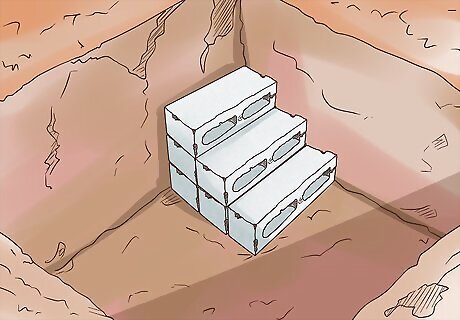
Arrange a way to get in and out. Depending on how deep your fort is you may want to build in a step to help you get back out of the pit you've dug. You can either carve small notches into the walls at appropriate distances for your reach to climb in and out, or you can build up a small block at the base of your fort. To make an easy step you can use a couple of bricks or a cinder block. Just be sure to pack dirt all around the blocks, about an inch thick to cover sharp edges and corners. To make a rope ladder get nautical rope, or nylon cord, around 1 inch in thickness and find a nearby tree or drive a post into the ground a couple feet away as an anchor for the rope. Wrap one end of your rope around the post or tree and tie an overhand knot. Tie more overhand knots in the rope at appropriate distances for you to reach with your hands and feet. Then you can cut off the end of the rope after it reaches the base of your fort. This is a fun way to climb out, but only if you already have a safe alternative such as a step.
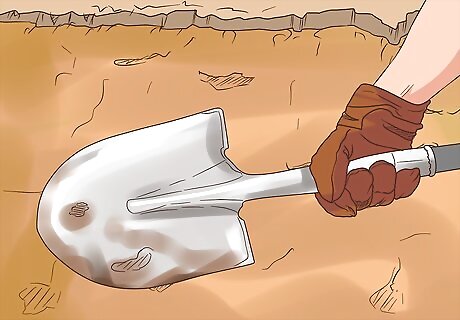
Smooth out the walls. The walls of your fort should be somewhat smooth and clear of tree roots or rocks that may stick out and harm you on your way in or out. To help keep your fort walls strong, put gloves on and pat the walls down. You can also use the flat side of a shovel to uniformly beat the walls until they are smooth and don't feel crumbly to the touch. You can also cover the walls of your fort by cutting plywood boards to the size of each wall. You want the plywood flush with the walls starting at the base of the fort. Drive two pressure treated 2x4 posts down at each corner of your fort and then nail or screw the plywood edges to the 2x4s to create siding. The posts should touch on one corner, creating a small box of space at each fort corner with the 4inch side of the 2x4 flush with the walls, if you're looking from above.
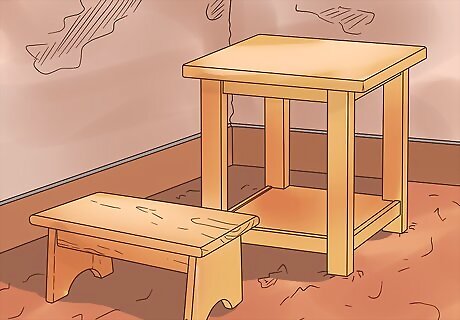
Make it cozy. Check out thrift stores for small wooden stools and tables that are the right size to bring into your fort, but only if it is large enough for a sitting area. You can also lay out a blanket for the floor, just make sure your parents don't mind it getting dirty or use one you found from a thrift store. Take any blankets or cushions you bring out to the fort back inside after use each time so they won't become damp and get moldy.
Building a Roof or Cover
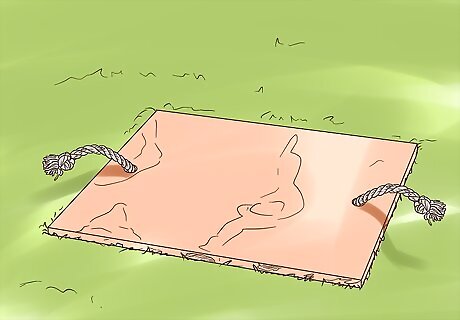
Use a plywood or wood cover. To cover your fort when it's not in use, you can use a piece of plywood that is at least a couple inches larger than the fort on all sides. Drill a hole in the plywood near one end to tie nylon cord or thick rope through. Use the rope as a handle to lift the wood off the fort when you're ready to use it. You can also horizontally stack long sticks over the entrance if they reach a few inches longer than the fort and won't fall in. For a more durable alternative, use 2x4 pieces of wood, so long as they reach. You'll want to cover the sticks and/or 2x4s with cut-out patches of grass for excellent protection from the rain and to keep the fort insulated. Moss is another fantastic way to cover a stick roof over your fort and make it water-tight.

Use a tarp. Tarps are a great way to keep rain out of your fort. You can string up a tarp using trees around the area or by driving 4 poles into the ground. Pull the tarp taught to create a roof a couple feet over the fort, or drape the tarp over taught string, running right over the fort, and tie the corner to the ground to create a tarp A-frame. You'll want to place markers around the entrance so no one will accidentally fall in the pit.

Use an above-ground shelter as a roof. Build an A-frame or a lean-to over the entrance of your fort for more room above-ground and to help block the weather. The A-frame is built with three initial logs; one long piece of wood held up on one end at the intersection of two shorter logs in the shape of an 'A', or upside down 'V' which have been driven into the ground. The open pit will be located in the middle of the triangle shape that the A-frame makes. Sticks are then placed parallel to the two shorter logs all the way down the body of the long piece of wood. A light layer of mud can be packed into the frame to create a roof. You can then add pine cones, needles, leaves, and other natural material on top for camouflage. The lean-to is started by hammering two poles into the ground slightly over the fort. The poles will then hold a board up which will be the peak of a slanted roof down to the ground. Again, sticks can be nailed to the peak of the roof, gradually getting shorter until you reach the bottom of the roof where it touches the ground. This can also be packed with a layer of mud and covered with clay, leaves, pine needles, and/or other natural material to mask the roof.


















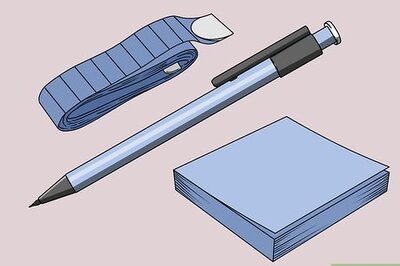
Comments
0 comment